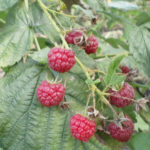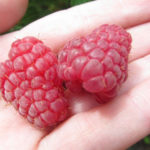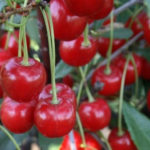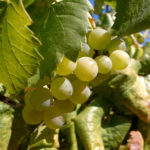Grape variety Original
Table grape variety Original - the result of the work of a team of scientists from the Ukrainian Institute of Viticulture and Winemaking named after V.E. Tairov. In more than thirty years that have passed since the appearance of the popular variety, several varieties have appeared that are similar in many respects, but differ in the color of the berries. The authentic original has a pink color, and this is exactly what it was included in the State Register of Plants of Ukraine and the State Register of Breeding Achievements approved for use on the territory of the Russian Federation.
The new form was bred in 1987 by crossing Turkish grapes under the name Damascus rose (Chaush pink) and the complex-resistant interspecific hybrid Muscat de Saint-Valier, which is widely used in breeding. The authors of the novelty are: V.A. Efremov, E.N. Dokuchaeva, L.F. Meleshko, M.I. Tulaeva, A.V. Dashkevich, A.K. Samborskaya, L.I. Tarakhtiy, T.V. Shane.
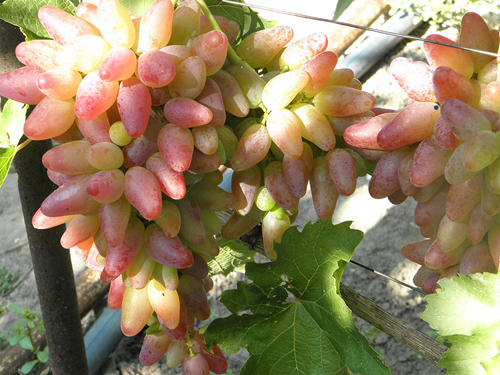
For its time, the variety looked revolutionary: a large bunch with very large berries of an unusual nipple shape, an elegant pink color. Thanks to this combination of aesthetic qualities, the Original very quickly gained popularity among both farmers and home culture. The beauty of the bunch made winegrowers turn a blind eye to clearly not outstanding economic qualities, such as low frost resistance, insufficient quality pollination in unfavorable years, poor transportability of bunches and a relatively late ripening period.
Nowadays, when it becomes difficult to surprise sophisticated amateurs with a variety of sizes, shapes and colors of grapes, interest in the Original has somewhat diminished, including due to the presence of no less impressive hybrid forms that have a much less capricious character. At the same time, there are still a significant number of fans of the variety, it is cultivated on significant areas and, in addition to its shortcomings, also has very obvious advantages. Among them, for example, increased resistance to fungal diseases, which makes it possible to grow environmentally friendly grapes with minimal treatments with chemical plant protection agents. All this suggests that it is too early to write off our hero, and he is ready to continue to compete with numerous newfangled hybrids.
The original is zoned in the southern regions of Ukraine and the North Caucasian region of the Russian Federation (the Republic of North Ossetia-Alania, Ingushetia, Adygea, Kabardino-Balkaria, Dagestan, Chechen, Crimea, Rostov region, Krasnodar and Stavropol Territories), but by amateur winegrowers it is grown for much more vast territory.
Agrobiological characteristics of the variety
Plants are highly vigorous. The leaf is large, somewhat stretched in width, five-lobed, moderately dissected. From above, the leaf blade is smooth and shiny, from below it is covered with bristly pubescence of medium intensity. The lateral notches are shallow, in the form of a reentrant angle, or barely outlined. The petiole notch is open lyre-shaped, with a bottom limited by veins. The teeth along the edge of the plate are large, saw-shaped, with slightly convex edges and pointed apices. The flowers of the grapes are bisexual, pollinated well under normal conditions, but in years with unfavorable conditions for flowering, a noticeable pea of berries appears. Ripening of shoots is sufficient - more than half, in its process the annual growth changes its color from green, first to reddish, and then to light brown.

The bunches of the variety are large and very large, with an average weight of 400-600 grams, maximum - up to 2 kg. They are elongated-conical in shape, with good pollination, rather dense, with the original arrangement of elongated grapes in different directions, which gives the ripened brushes of the Original a resemblance to a hedgehog. The comb and stems of berries are of medium length, fragile.The attachment of the grapes to the ridge is not strong enough. The berries are magnificent - about 30 mm long and about 22 mm in diameter, of an unusual decorative nipple shape with a pointed slightly curved tip and an interception around the circumference, with an average weight of 6-7 grams. The color of the fruits is pleasant white-pink, and in good sunlight during the ripening period, it is completely pink. In some seasons, within the bunch, a significant variety of berries can be observed, but in most cases they are still fairly aligned. The pulp has a simple harmonious taste, juicy, sometimes even liquidish, without a specific varietal aroma. Uncolored juice, sugar content 19-21 grams / 100 ml, acidity - 5-6 grams / liter. The peel is thicker than medium, firm, but edible, covered with a light bloom of light-colored prune on the surface. There are 2-3 seeds in the berry, they are felt when consumed, slightly reducing the taste characteristics of the grapes. The overall tasting score of the fruit is 8.8 points.
Most of the harvest of this variety is used for fresh consumption. At the same time, the possibility of its use as a raw material for home preservation is not completely ruled out. The original has a high marketable appearance, bribing buyers with stunningly beautiful berries. At the same time, in terms of taste, it is not standard, and the transportability of the collected bunches is completely lame due to a predisposition to shedding berries. But thanks to the strong skin, storage of grapes in favorable conditions can continue until the New Year.
The ripening period is medium late. In the south, the bunches reach removable ripeness in mid-September, or 135-145 days after bud break. The sum of active temperatures required during the growing season is 2800-2900 ° C. For many relatively northern regions, where varieties of early ripening ripen without problems, the Original may no longer be suitable. In addition, frost resistance brings it down. The temperature of -21 ° C is critical for the aboveground part of the plant, which requires its shelter even in traditional wine-growing regions. Not distinguished by excessive abundance and productivity of grapes. On average, 8-10 kilograms of berries are obtained from an adult bush, and about 100-120 centners from a hectare of plantations. The fruitfulness of the shoots is 65-80%, the number of brushes per fruitful shoot is 1.2-1.7. The risk of overloading the bushes with crops is negligible. Under satisfactory wintering conditions, the opening of the eyes in spring is 84%.
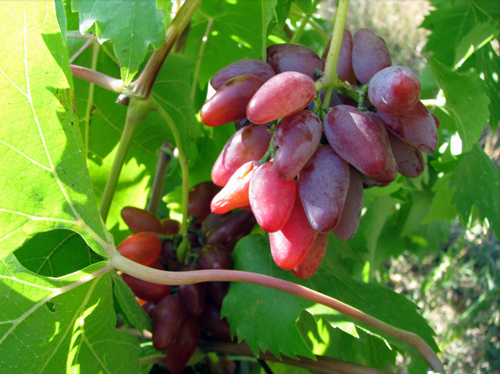
If the climate and temperature conditions allow in the fall, the ripe crop can continue to hang on the bushes for a long time. Due to its dense skin, it is not characterized by cracking, decay, or damage by wasps. The only ones who can pester are birds that flock to the vineyards in autumn. Well, the collection of the overripe crop will need to be carried out as carefully as possible, since the grapes by this time can easily crumble from the brush.
Agrotechnical features
From an agrotechnical point of view, the Original is a rather controversial variety, possessing both definitely weaknesses and undoubted advantages. The first, as already noted, include insufficient frost resistance, as well as a tendency to peel berries and loosen the bunch due to insufficient pollination of the inflorescences. In addition, despite the absence of a strong predisposition to overloading the bushes with the harvest, the plants actively lay inflorescences on the stepchildren, diverting food from the main crop to the stepson, which still has no chance of ripening. The positive qualities of this grape undoubtedly include increased resistance to pests and diseases, good rooting of cuttings and compatibility with common rootstocks, active growth and early entry into fruiting.
The original does not have any special requirements for placement conditions. It grows well on soils of various texture and fertility, it does not tolerate only acidic and saline soils, as well as places with shallow groundwater.You should also not plant a vineyard on the cold northern slopes and lowlands. In household plots, it is advisable to plant bushes on the south side of buildings, fences and hedges, protected from cold northern winds.
The variety is tolerant to phylloxera, and therefore, on light sandy soils, even in the zone of continuous phylloxera infestation, planting with rooted cuttings is possible. It is advisable to use the grafted ones only on heavy soils, where this pest of grapes is especially harmful. The advantage of own-rooted culture also lies in the faster entry of the vineyard into fruiting - already in the second year, "signal" clusters appear on the bushes, and in the third year you can get the first full harvest. The grafted plants are usually delayed in development for a year.
The most suitable shaping for the Original is the multi-arm fan, due to its adaptability to sheltering vines for the winter and the convenience for long pruning, to which the variety is demanding. The thickness of the covering layer depends on the frost hazard of a particular region. In the mildest conditions, it is enough to drop the vine removed from the trellis into the ground, while if there is a risk of severe cold weather in winter, it is necessary to cover the grape bushes with all care, using organic insulation (straw, sawdust, reeds, spruce branches) and waterproofing (film, roofing material , wooden boards).
Spring pruning is carried out at the rate of 45-60 eyes per plant, with a pruning length of 8-12 buds of fruit arrows. Such a high load is associated with insufficient fertility of the lower eyes, which is why, after awakening the buds, all unnecessary sterile shoots, as well as weak productive ones, must be removed. The brushes on the shoots of the Original are thinned out if they want to get bunches of outstanding size, weighing more than a kilogram. If this is not done, then their sizes will be at the level of the standard 500-600 grams for the variety. It is imperative to carry out regular pinching and preferably chasing shoots at the end of the growing season. The first method will allow not to thicken the bushes and not waste the vital energy of the plant on useless stepson fruiting, and the second will improve the ripening of the shoots and the main harvest. In addition, it will not be superfluous to clarify the bunches by removing leaves in the fruit zone, which will best reflect on the organoleptic characteristics of the grapes and its color.
To combat fungal diseases, single preventive treatments with chemical preparations and point control of the development of pathogens during periods of optimal conditions for their reproduction are sufficient. The variety is resistant to gray mold, and is also tolerant to powdery mildew, mildew and black spot.
In order to prevent the peas of grape berries, you can work on additional manual pollination of the inflorescences with powder puffs, and then you can be absolutely sure of the magnificent appearance of the ripe bunches of the Original in the fall.

